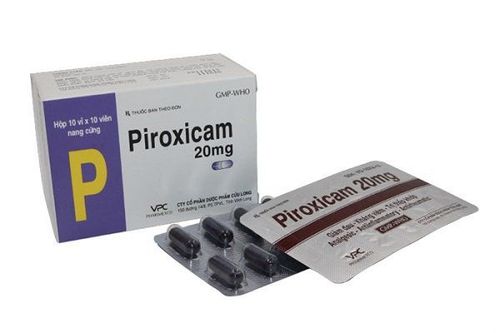This is an automatically translated article.
Piroxicam is commonly used to treat inflammation and pain in the joints. To use Piroxicam safely and effectively, patients should consult their doctor, pharmacist before taking.
1. What is Piroxicam?
Piroxicam is a non-steroidal anti-inflammatory pain reliever. Due to its ability to reduce fever less than Aspirin but reduce pain and inflammation stronger, Piroxicam is mainly used to treat inflammatory diseases, musculoskeletal pain,... In 2013, Piroxicam appeared in the drug list. Essential medicine for the 6th time.
Piroxicam is now widely circulated on the market, you can see Piroxicam in many forms such as 10-20mg tablets, 10-20mg capsules, 20mg/ml injections, tablets. rectally 20mg.
Dosage of Piroxicam is 20mg orally once a day, this is the maximum recommended dose.

Piroxicam là thuốc gì? Thuốc có tác dụng chống viêm, giảm đau và hạ sốt.
2. What are the uses of Piroxicam 20mg?
Piroxicam has a quick analgesic effect after half an hour when taken (the strongest after 3-5 hours, when the concentration of the drug in the blood reaches the highest level). Depending on the condition of each patient, the therapeutic ability of Piroxicam 20mg is stable after 4-13 days. Thanks to its good pain-relieving ability, Piroxicam is often used in musculoskeletal diseases such as:
Acute musculoskeletal diseases, sports injuries to reduce pain and anti-inflammatory; Treatment in chronic rheumatic diseases such as rheumatoid arthritis, osteoarthritis; Ankylosing spondylitis ; Acute gout. The mechanism of action of the drug Piroxicam is not clear yet, but to produce such a rapid anti-inflammatory effect, it may be due to the inhibition of prostaglandin synthetase, thereby preventing thromboxane, prostaglandin and other products of the enzyme cyclooxygenase from creating Fort.
Piroxicam is less soluble in fat, so it penetrates well into the synovial fluid and inflammatory tissues.
However, Piroxicam is not indicated first in non-steroidal anti-inflammatory drugs. In addition, piroxicam can also be used in patients with dysmenorrhea and pain relief after surgery.
3. What are the effects of Piroxicam 20mg?
3.1 Piroxicam 20mg harmful to the digestive tract Like other NSAIDs, Piroxicam also has some unwanted effects on your gastrointestinal tract. According to statistics, more than 15% of patients experience this type of side effect, but it does not interfere too much with the treatment process, in fact only about 5% of people have to stop treatment with Piroxicam. But if you're suffering from a peptic ulcer, tell your doctor right away during your check-up.
Common gastrointestinal symptoms include:
Anorexia, epigastric pain, nausea, constipation, abdominal pain, diarrhea, dyspepsia encountered in more than 1% of people using Piroxicam. Gastrointestinal bleeding, perforation and peptic ulcer; Dry mouth is less common, the number of people suffering from it is only 0.1-1%. If you experience any of these symptoms, tell your doctor or pharmacist right away to change your dose or stop using it as needed.
3.2. Does Piroxicam 20mg cause allergies? Piroxicam can cause allergies. Tell your doctor if you have ever had an allergic reaction to Piroxicam or a non-steroidal anti-inflammatory drug such as Aspirin. If you use it for the first time, watch out for allergy symptoms such as rash; shortness of breath; swelling of the face, lips, tongue or throat and tell your doctor right away.
3.3. Does piroxicam 20mg have any effect on the body? Piroxicam may cause some patients to experience an unpleasant headache, fever (flu-like), and, rarely, generalized fatigue.

Hãy hỏi ý kiến bác sĩ trước khi sử dụng thuốc Piroxicam nếu bạn bị loét dạ dày tá tràng
3.4. What effect does Piroxicam have on the blood? Piroxicam has an antiplatelet effect, making it difficult for bleeding wounds to clot and scab. So if you are in a job with a high risk of bleeding, tell your doctor or pharmacist. Some specific side effects such as: Decrease in hemoglobin and hematocrit, anemia, leukopenia, eosinophilia, less common side effects are thrombocytopenia, bleeding points, bruising, depression. marrow.
3.5. Undesirable effects on the heart, lungs, liver, kidneys Blood flow to the kidneys is reduced because Piroxicam inhibits prostaglandin synthesis. This is especially important in patients with hepatic, renal, or cardiac failure and with plasma volume changes. Decreased renal prostaglandin production can lead to fluid retention, renal failure, and acute heart failure.
On the kidneys: Increased blood urea and creatinine, more rarely hematuria, proteinuria, interstitial nephritis, nephrotic syndrome, dysuria. On the liver: Abnormal liver function, jaundice, Hepatitis. People with a history of bronchospasm, asthma, nasal polyps and Quincke's edema should tell their doctor because of some cardiac and respiratory side effects such as edema, which are rarer but more severe such as hypertension, congestive heart failure. blood gets heavier.
3.6. Does Piroxicam 20mg have any effect on the nervous system? Piroxicam drugs penetrate poorly into nerve tissues, so they have very few undesirable effects on nerves. However, you may still experience some symptoms such as dizziness, dizziness, drowsiness, more severe but rare such as depression, insomnia, restlessness, irritability, hallucinations, mood changes, confusion, paranoia.
3.7. Effects on Pregnancy and Lactation As noted above, drugs that inhibit the synthesis and release of other prostaglandins, may increase residual pulmonary pressure in the neonate due to antenatal closure of the ductus arteriosus. , prolongation of pregnancy and gastrointestinal toxicity in pregnant women, and inhibition of labor in women about to give birth if Piroxicam is used during the last 3 months of pregnancy.
As for nursing mothers, the safety of the drug has not been established, should be used with caution.
3.8. Does Piroxicam have any adverse effects on the elderly? Carefully adjust the dose when used for the elderly, especially those with a history of peptic ulcer, liver failure, kidney failure, cardiovascular disease, bleeding disorders, diuretics.
3.9. Does piroxicam have any effect on children? The safety and effectiveness of Piroxicam in children have not been established. When using Piroxicam 20mg for children, it is best to consult a doctor.

Cần thận trọng khi sử dụng thuốc đối với người cao tuổi tránh gặp các tác dụng phụ không mong muốn
4. Drug interactions of Piroxicam
Some drugs can cause interactions when used with Piroxicam 20mg, such as:
Coumarin anticoagulants: Piroxicam can push other drugs out of plasma proteins; Aspirin : Lowers plasma concentrations of Piroxicam; Lithium drugs: Increased lithium toxicity.
5. Notes when using and storing Piroxicam at home
Take Piroxicam 20mg with a full glass of water and should not lie down for 10 minutes after drinking; Piroxicam is not affected by antacids or substances in dairy foods, so you can take them together to avoid stomach upset; Do not increase the dose on your own, if you forget to take the medicine, take the next dose at the next time. Absolutely do not make up for a double dose; When an overdose of Piroxicam has the following symptoms: feeling of lack of energy, drowsiness, upset stomach, vomiting, abdominal pain, black or bloody stools, difficulty breathing, coma. Activated charcoal can reduce the absorption and reabsorption of Piroxicam, so take the patient to the nearest medical facility for timely treatment; It is necessary to keep the medicine in a cool place, especially for injections, avoid light, and suppositories to avoid heat. Piroxicam is contraindicated in certain cases. Therefore, patients should consult their doctors and pharmacists before using to ensure health safety and increase treatment effectiveness.
Please dial HOTLINE for more information or register for an appointment HERE. Download MyVinmec app to make appointments faster and to manage your bookings easily.













